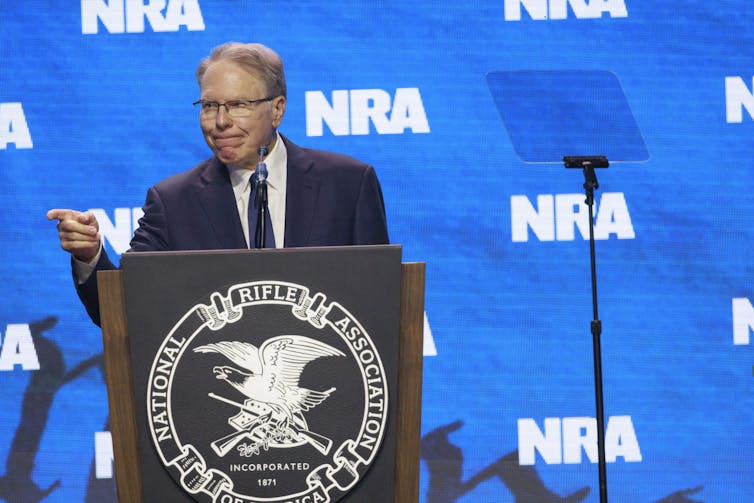
More than three years after New York authorities sued the National Rifle Association and four of its current and former leaders, the trial will begin on Jan. 8, 2024.
In her complaint, New York Attorney General Letitia James alleges that outgoing NRA Executive Vice President Wayne LaPierre “exploited the organization for his financial benefit, and the benefit of a close circle of NRA staff, board members, and vendors,” ultimately diverting over US$63 million from legitimate uses.
And yet, the NRA had a 76-member board of directors, as well as a designated audit committee, which both had mandates to monitor the organization’s financial health. By reviewing transactions involving the NRA and its leaders more skeptically, the board might have helped the NRA avert some of its current legal troubles.
I’m a nonprofit law scholar. Together with Claire Hill, a University of Minnesota law professor, I’ve explored one way nonprofits might theoretically avert debacles, both large and small, in the future. We believe nonprofit boards should require their members to take turns serving as “designated contrarians.” When it’s their turn for this role, board members would be responsible for asking critical questions and pushing for deeper debate about organizational decisions.
Board culture
State law in New York, where the NRA is chartered, tasks boards of directors with the ultimate oversight over nonprofits and their leaders.
They’re responsible for everything from weighing in on strategies to advance the organization’s mission to hiring and evaluating top executives and setting their salaries.
Directors aren’t supposed to manage a nonprofit’s everyday affairs. But they are supposed to be on the lookout for major problems and speak up if its resources are being wasted – or worse.
The NRA’s board, like all nonprofit boards, had an obligation to detect the alleged wrongdoing and intervene to stop it.
Some NRA leaders did object to what they perceived as wasteful spending by the nonprofit and its leaders, according to James’ complaint. In some cases, concerned trustees resigned or were forced out.
But in general, it appears that NRA board members did little to oversee or restrain LaPierre, even when one top leader unsuccessfully sought big changes.
On Jan. 5, three days before the trial was scheduled to begin, LaPierre announced his resignation − effective Jan. 31. The 74-year-old NRA leader cited “health reasons” rather than board pressure for his exit from the organization he had led since 1991.
James responded to the news by promising that this move “will not insulate [LaPierre] from accountability.”

Too passive
Not every nonprofit board needs to rein in leaders squandering millions on personal travel and hundreds of thousands on bespoke suits, as LaPierre allegedly did. But it’s too easy for their members to be too passive.
That is, board members often fail to ask hard questions and challenge the organization’s paid staff – especially when there are more than a dozen or so people serving as directors.
One reason for this is that nonprofit directors usually volunteer their time and don’t get paid for their contributions. In fact, they often donate their own money to their organizations because they value their charitable missions.
The NRA strayed from this norm. The group was paying 18 of its board members when much of the alleged wrongdoing occurred.
It’s only natural for nonprofit directors to presume that their colleagues on the board share their good intentions. What’s more, it’s natural to show deference in the presence of the executives leading the organization full time and the major donors upon whose generosity the group may depend.
No matter the context, many people will simply find it uncomfortable to rock the boat. Sometimes, overly passive and deferential boards turn into rubber stamps that fail to challenge sloppy bookkeeping or question unwise hires.
What should they do?
We propose that trustees take turns being a designated contrarian, temporarily becoming a devil’s advocate obliged to challenge proposed board actions.
To be clear, they wouldn’t be naysayers out to block everything. They would instead ask probing questions and offer feedback on reports by executives and officers. They would also initiate critical discussions by challenging conventional wisdom.
The goal would be to encourage debate and reflection about the nonprofit’s decisions, slowing – or halting, if necessary – the approval of business as usual.
Board members might serve as the designated contrarian for only a few meetings. The duration of this role would probably depend on how big a given board is and how often it meets.
While this is primarily just a theory at this point, we anticipate that over time, as more and more directors have served as designated contrarians, boards will become more open to constructive dissent.
Rare examples among nonprofits
Although using designated contrarians is not yet a widely used practice, a few nonprofit boards may have already embraced this concept.
For example, I’ve been told but have been unable to confirm that one major grantmaker’s investment committee tasks one of its members with challenging particular investment decisions.
This technique may have been gleaned from experiences in finance, where some fund managers rely on a devil’s advocate to test investment decisions, and at least one study found that this practice can improve outcomes.
Harvard Business Review has published guidelines recommending the designation of “strategic dissenters,” and experts from the McKinsey consulting firm cite the value of assigning devil’s advocates on high-functioning, for-profit boards.
I’ve also heard about another unnamed nonprofit tasking a board member as a “process observer.” They were responsible for speaking up when their board was either overly passive or the opposite – micromanaging staff.
No sure thing
Of course, embracing a rotating contrarian alone would not be enough to convert the NRA’s unusually large board into a lean and engaged governing body able to detect and prevent all of its alleged wrongdoing. And even for nonprofit boards in less dire circumstances, using rotating contrarians has its challenges.
Most serious among these is whether rotating contrarians will offer only inauthentic dissent, which studies show provides limited benefits. Serving a term as contrarian will not magically transform a passive and deferential person into someone who actively challenges dominant voices or forcefully advocates alternatives. And directors wearing the contrarian hat may be too easily discounted if others perceive them as merely mouthing their assigned lines.
To be sure, organizations that adopt this approach would need to be patient.
I doubt that they will be able to summon authentic dissent right away. And newly designated contrarians will be no match for long-standing organizational leaders willing to deceive their boards and punish dissenters.
But I do believe that once board members who have served as contrarians get the hang of articulating authentic dissent, they could begin to make the nonprofits that they oversee more accountable.
This article was updated on Jan. 5, 2024, with news of Wayne LaPierre’s resignation.
Dana Brakman Reiser does not work for, consult, own shares in or receive funding from any company or organization that would benefit from this article, and has disclosed no relevant affiliations beyond their academic appointment.
This article was originally published on The Conversation. Read the original article.







